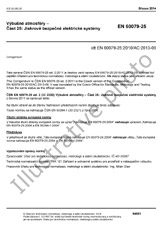We need your consent to use the individual data so that you can see information about your interests, among other things. Click "OK" to give your consent.

CISPR 15-ed.8.1
Limits and methods of measurement of radio disturbance characteristics of electrical lighting and similar equipment
STANDARD published on 27.3.2015
| Availability | Sold out |
| Price | ON REQUEST excl. VAT |
| ON REQUEST |
The information about the standard:
Designation standards: CISPR 15-ed.8.1
Publication date standards: 27.3.2015
SKU: NS-583700
The number of pages: 300
Approximate weight : 931 g (2.05 lbs)
Country: International technical standard
The category - similar standards:
Annotation of standard text CISPR 15-ed.8.1 :
CISPR 15:2013+A1:2015 applies to the emission (radiated and conducted) of radiofrequency disturbances from: - all lighting equipment with a primary function of generating and/or distributing light intended for illumination purposes, and intended either for connection to the low voltage electricity supplyor for battery operation; - the lighting part of multi-function equipment where one of theprimary functions of this is illumination; - independent auxiliaries exclusively for use with lighting equipment; - UV and IR radiation equipment; - neon advertising signs; - street/flood lighting intended for outdoor use; - and transport lighting (installed in buses and trains). Excludedfrom the scope of this standard are: - lighting equipment operating in the ISM frequency bands (as defined in Resolution 63 (1979) of the ITU Radio Regulation);- lighting equipment for aircraft and airports; - and apparatus for which the electromagnetic compatibility requirements in the radio-frequency range are explicitly formulatedin other CISPR standards. The frequency range covered is 9 kHz to 400 GHz. This eighth edition cancels and replaces the seventh edition published in 2005, its Amendment 1 (2006) and Amendment 2 (2008). It is a technical revision. This edition includes the following significant technical changes with respect to the previousedition: - inclusion of LED light sources and luminaires, clarification oftest supply voltage and frequency, and improvements to clause 5 relating to the application of limits to the various types of lighting equipment covered under the scope of CISPR 15; - introduction of requirements for flashing type emergency lightingluminaires utilizing xenon lamps; - introduction of requirements for neon and other advertising signs; - and clarification of the requirement for radiated disturbances between 30 MHz and 300 MHz in case the operating frequency of the light source is below 100 Hz. The contents of the interpretation sheet 1 and 2 of june 2013 havebeen including in this copy. This consolidated version consists of the eigth edition (2013) and its amendment 1 (2015). Therefore, no need to order amendment inaddition to this publication. Le CISPR 15:2013+A1:2015 concerne l?©mission (rayonn?©e et conduite) des perturbations radio?©lectriques: - de tous les appareils d?©clairage dont la fonction principale estde produire et/ou de distribuer la lumi?¨re, qui sont pr?©vus ? des fins d?©clairement lumineux et destin?©s ? ??tre raccord?©s au r?©seau dalimentation ?©lectrique ? basse tension ou ? fonctionner sur piles; - de la partie des appareils ? fonctions multiples destin?©e ? l?©clairage lorsquune des principales fonctions de ces appareilsest l?©clairement lumineux; - des appareils auxiliaires ind?©pendants exclusivement destin?©s ? ??tre utilis?©s avec les appareils d?©clairage; - des appareils ? rayonnement ultraviolet et infrarouge; - des enseignes publicitaires au n?©on; - des appareils d?©clairage public/?©clairage dambiance uniquementdestin?©s ? lutilisation ext?©rieure; - et des appareils d?©clairage des moyens de transport (install?©s dans les bus et les trains). Les appareils suivants sont exclus dudomaine dapplication de la pr?©sente norme: - les dispositifs d?©clairage fonctionnant dans les bandes de fr?©quences ISM (telles que d?©finies dans la r?©solution 63 (1979) duR?¨glement des radiocommunications de lUIT); - les dispositifs d?©clairage pour avions et pour a?©roports; - et les appareils pour lesquels les exigences relatives ? la compatibilit?© ?©lectromagn?©tique dans la gamme des radiofr?©quences sont formul?©es de mani?¨re explicite dans dautres normes CISPR. Labande des fr?©quences couvertes s?©tend de 9 kHz ? 400 GHz. Cette ?©dition inclut les modifications techniques majeures suivantes parrapport ? l?©dition pr?©c?©dente: - inclusion de sources lumineuses LED et luminaires associ?©s, clarification de la fr?©quence et de la tension dalimentation dessai, et am?©liorations apport?©es ? larticle 5 ayant trait ? lapplication des limites des diff?©rents types dappareils d?©clairage vis?©s par le domaine dapplication de la CISPR 15;- introduction dexigences relatives aux luminaires d?©clairage de secours de type ? ?©clats utilisant des lampes au x?©non; - introduction dexigences relatives aux enseignes au n?©on et autresenseignes publicitaires; - et clarification des exigences relatives aux perturbations rayonn?©es dans la plage comprise entre 30 MHz and 300 MHz dans le cas o?? la fr?©quence de fonctionnement de la source lumineuse se situe au-dessous de 100 Hz. Le contenu des feuilles dinterpr?©tation 1 et 2 de juin 2013 a ?©t?©pris en consid?©ration dans cet exemplaire. Cette version consolid?©e comprend la huiti?¨me ?©dition (2013) etson amendement 1 (2015). Il nest donc pas n?©cessaire de commander lamendement avec cette publication.
We recommend:
Technical standards updating
Do you want to make sure you use only the valid technical standards?
We can offer you a solution which will provide you a monthly overview concerning the updating of standards which you use.
Would you like to know more? Look at this page.



 Cookies
Cookies
